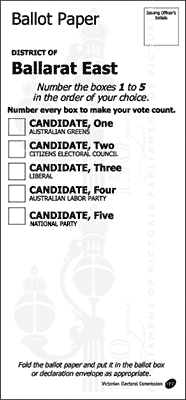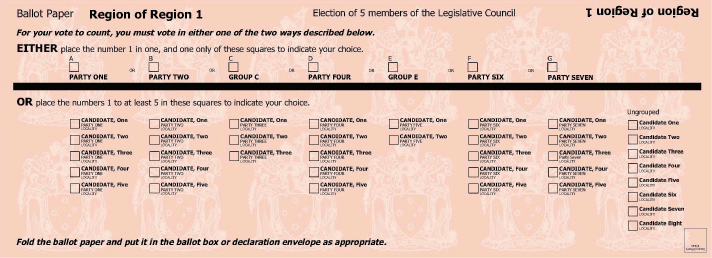How to vote: State elections
State elections are held every four years on the last Saturday in November. The elections are independently conducted by the VEC.
The next State election will be held on Saturday, 24 November 2018.
Who am I electing?
The Parliament of Victoria is divided into:
- the Legislative Assembly (Lower House) and
- the Legislative Council (Upper House).
When you vote at a State election, you are voting for one person to represent your district in the Legislative Assembly and five people to represent your region in the Legislative Council.
The Legislative Assembly
There are 88 members in the Legislative Assembly (Lower House) (external link), one for each district in Victoria. After the election, the party or coalition (group of parties) with most seats in the Lower House forms government.
Members of the Legislative Assembly are elected to serve a term of four years.
How to vote for the Legislative Assembly
To complete a ballot paper for the Legislative Assembly (Lower House) place a 1 in the box of your preferred candidate, and then number all the remaining boxes in the order of your preference. This is called full preferential voting.

An example of a State Legislative Assembly (Lower House) ballot paper
The Legislative Council
There are 40 members in the Legislative Council (Upper House) (external link). Victoria is divided into eight regions and each region has five members. The Legislative Council is often called the 'house of review' as it is the role of the Upper House to review legislation that has been passed in the Lower House.
Members of the Legislative Council are elected to serve a term of four years.
How to vote for the Legislative Council
The Legislative Council (Upper House) ballot paper features a thick horizontal line (as shown below). You can vote above or below the line.
- If you choose to vote above the line, you must only place a 1 in the box above the party you want to support. Your ballot paper will be counted according to the preferences on the group's registered group voting ticket.
- If you choose to vote below the line, place a 1 in the box against your most preferred candidate and continue numbering 2,3,4,5 and so on in order of your choice.. You are only required to number a total of five preferences (i.e. 2, 3, 4 and 5), but can number more. This is called optional preferential voting.

An example of a State Legislative Council (Upper House) ballot paper
Who are my members of Parliament?
For details about currently elected members of Parliament, please visit the Parliament of Victoria website (external link).
What is the timeline for a State election?
| Time | Event |
|---|---|
| 25 days before election day | Expiry of the Lower House
The term of the Legislative Assembly expires and the Governor of Victoria issues the writ for the election. Issue of the writThe issue of the writ starts the election process. An electoral writ is a document commanding the Victorian Electoral Commission to hold an election, and contains dates for the close of rolls, the close of nominations and the return of the writs. Two writs are actually issued, one for the Legislative Assembly (Lower House) and one for the Legislative Council (Upper House). Opening of nominationsOnce the electoral writ has been issued, candidates can lodge their nomination for election. |
| 18 days before election day | Close of rolls
People have until 8:00pm, seven days after the writ is issued to enrol, or to update their enrolment. |
| 15 days before election day | Close of nominations
Candidates can nominate up until 12 noon, 10 days after the issue of the writ. |
| Election day | The day most voters cast their vote. It must be the last Saturday in November and 25 days after the issue of the writ. |
| Up to 21 days after election day | Return of the writ
After the results are declared, the Victorian Electoral Commission returns the writs, endorsed with the names of the successful candidates, to the Governor. |
State by-elections
The timeline differs for a State District by-election.
The writ for a by-election is issued by the speaker of the Legislative Assembly.

